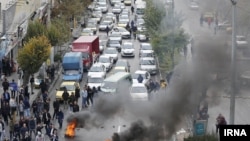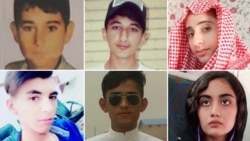Amnesty International says the families of the more than 300 people who were killed by Iran’s security forces during November’s “ruthless” crackdown on anti-government protests continue to face “intense harassment and intimidation” from the authorities as they seek justice.
Five days of protests erupted in Iran on November 15 following a government announcement about a fuel-price hike.
Amnesty International has recorded 304 men, women, and children who were killed by security forces’ during the demonstrations, but said it believed the real number is higher.
New research has again concluded that the use of lethal force against the vast majority of the recorded 304 victims was unlawful, the London-based human rights watchdog said in a statement on May 20.
In almost all of the protests, there is no evidence that people were in possession of firearms or that they posed an imminent threat to life that would have warranted the use of lethal force, according to research conducted by the group.
It cited two exceptions in the city of Mahshahr, Khuzestan Province, where gunfire was exchanged between protesters and security forces. The violence resulted in the death of one member of the Islamic Revolutionary Guards Corps (IRGC) and one police officer.
“The fact that so many people were shot while posing no threat whatsoever shows the sheer ruthlessness of the security forces’ unlawful killing spree,” said Philip Luther, Amnesty International’s Research and Advocacy Director for the Middle East and North Africa.
Six months after the crackdown, Iranian authorities have still not issued an official death toll and “the devastated families of victims continue their struggle for truth and justice while facing intense harassment and intimidation from the authorities,” Luther said.
On Wednesday, May 20 the United States sanctioned Iran's Interior Minister, Abdolreza Rahmani-Fazli who is said to be the main official in charge of coordinating the November crackdown. The U.S. accused him of human rights violations.
In December Reuters released an exclusive report saying up to 1,500 people were killed in the protests.
Such “impunity” afforded to the security forces “allows the recurrence of lethal force to crush dissent,” he added, reiterating Amnesty International’s call to members of the UN Human Rights Council to “mandate an inquiry into the killings, and identify pathways for truth, justice and reparations.”
The recorded 304 victims were killed in 37 cities in eight provinces across Iran, reflecting the “widespread nature of the crackdown,” the statement said.
The poverty-stricken suburbs around Tehran saw the most killings, with at least 163 deaths recorded. The minority-populated western provinces of Khuzestan and Kermanshah were also badly affected, with 57 and 30 deaths, respectively.
The recorded victims include 236 men, 10 women, and at least 23 children; the gender of the remaining 35 victims remains unknown to Amnesty International.
In all but four cases, the victims were shot dead by Iranian security forces – including IRGC members, paramilitary Basij forces, and the police – “firing live ammunition, often at the head or torso, indicating that they were shooting to kill.”
Two other victims reportedly suffered fatal head injuries after being beaten by members of the security forces, and another two were recorded as having suffocated from tear gas.
More than 220 of the recorded deaths took place over two days -- on November 16-17.
To conduct its research, Amnesty International said it has gathered evidence from videos and photographs, death and burial certificates, accounts from eyewitnesses and victims’ relatives and friends, as well as information collected by human rights activists and journalists.
During and after the demonstrations, it said thousands of protesters were “arbitrarily” detained and many were subjected to “enforced disappearance, torture and other ill-treatment, and unfair trials.”






